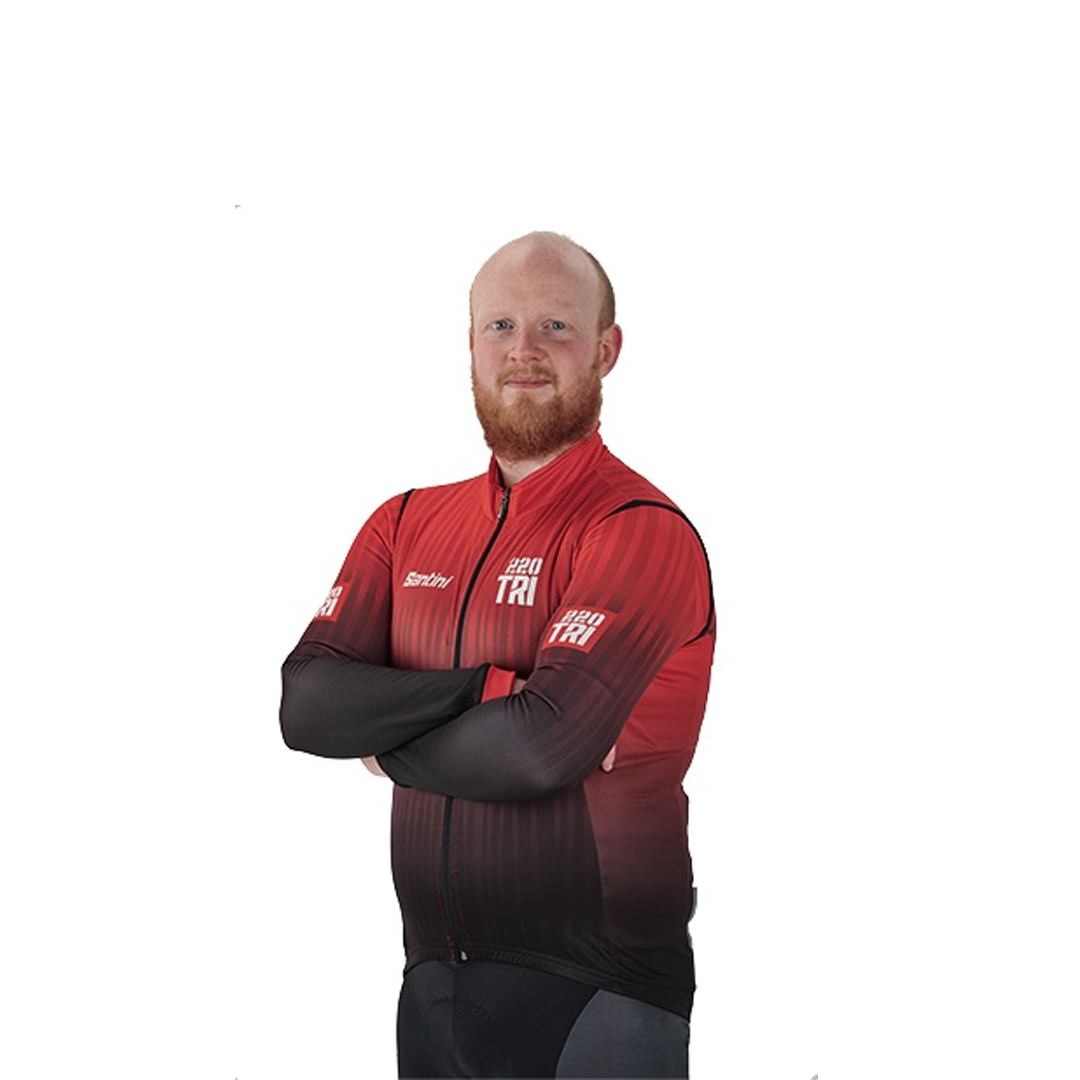While you can spend vast amounts of cash upgrading your triathlon bike, a poor tri saddle choice negates the aero gains of wheels and bars if discomfort accompanies every pedal stroke. That’s why you must find a triathlon-specific saddle that works for you.
Pain or numbness can, at best, leave you shuffling around on your saddle; at worst, you’ll require recuperative time off the bike. So it’s vital for both health and performance that you find a TT saddle that’ll allow you to hold a fixed position for long periods, especially if you’re an iron-distance triathlete.
Some bike shops offer a saddle-fitting service that includes measurement of your sit bones. This is well worth having – and we’d also suggest experimenting with different models. Ultimately, saddle choice is a personal thing.
What's the difference between a triathlon saddle and a road saddle?
Tri-specific saddles are different to road versions, as they’re optimised to provide support for your sit bones while perched further forward on your aerobars. This means a wider flat section at the nose. Another common feature is cut-out sections down the middle to relieve perineum pressure.
We must stress that TT saddles, like all saddles, are very personal. A good bike fit often includes saddle fitting and could flag up an unsuitable seat, while there are specialist bike shops that can offer sit-bone measurements to find a saddle with the correct width for your behind. If you’re struggling to find your perfect saddle, either of these options could be wise investment
Best triathlon-specific bike saddles in 2022
Selle Italia Watt Kit Carbonio Superflow

- £239.90
The carbon-railed version of Selle Italia’s Watt Kit Carbonio Superflow is two-time Kona winner Patrick Lange’s seat of choice, weighing 198g with a wide cut-out to provide pressure relief, and rails that are 10mm longer than its road saddles to ‘adapt the saddle to extreme aerodynamic positions’.
The nose (50mm wide at the tip), while considerably narrower than something like Fizik’s Mistica, is also long so you can find your ideal position.
The anti-slip cover has extra grips to hold you in place and the anatomicallyshaped rear provides plenty of comfort.
Before buying, take advantage of Selle Italia’s ‘idmatch’, an online questionnaire that picks your ideal saddle based on stats like height, body type and racing goals.
Verdict: As the price suggests, this is a luxury buy, but it does provide all-day comfort
Score: 84%
Ergon SR Road Pro Men
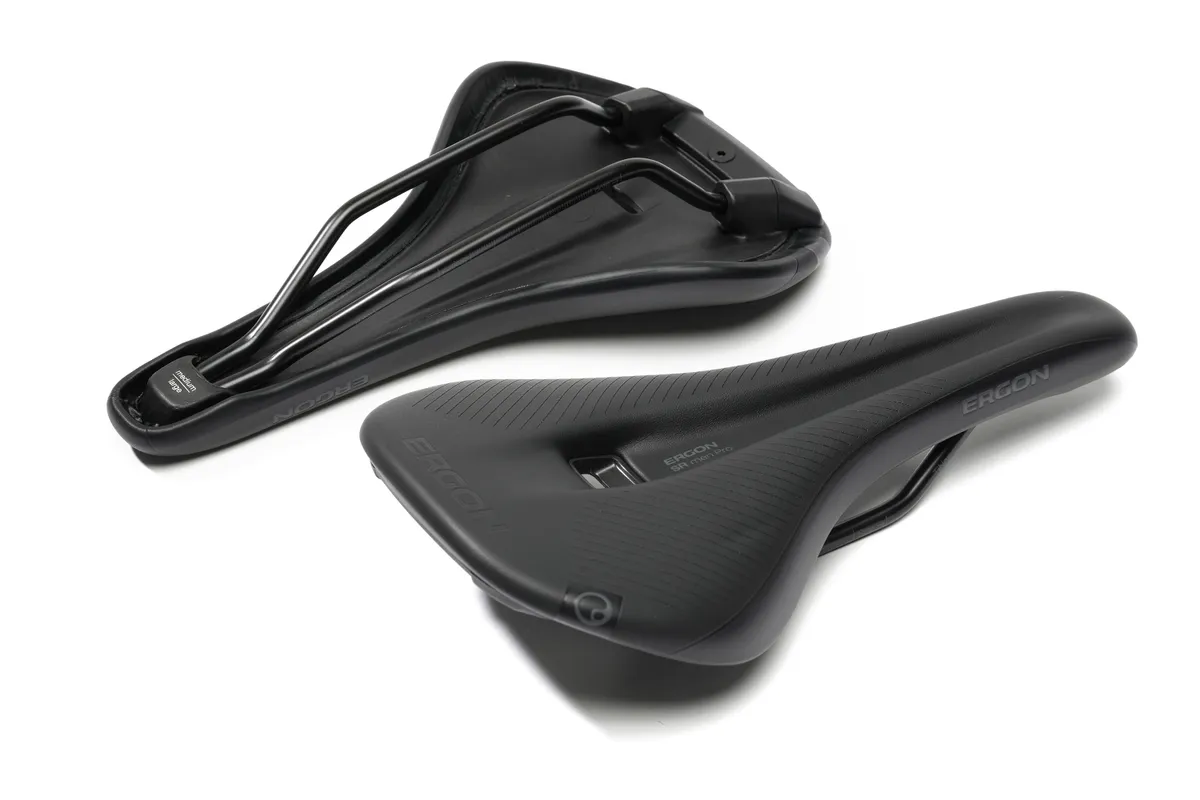
- £119.99
As Ergon’s Road Pro is aimed at road riding rather than triathlon, we whipped out the roadie for testing. You might have also guessed it’s aimed at male riders, so to suit the narrower male sit bones and more upright pelvis, the cut-out is narrower and further back compared to the women’s.
It comes in S/M and M/L sizes, with this tester going for M/L to suit 14.5cm sit bones. It took some work to get the position spot on because of the very pronounced square central cut-out, but once in a groove we found it fine for long rides.
As promised, the narrow front gave our legs freedom to pedal, and we didn’t experience unwanted perennial pressure.
The Road Pro has some clever features, so if you suffer from numbness and are looking for a road/ draft-legal tri saddle, go for it.
Verdict: Intelligently designed for the different genders; worth trying before buying
Score: 81%
Repente Magnet

- £240
This superlight saddle weighs just 135g, thanks in part to Repente’s advanced autoclaving technique that forces the carbon to be more uniform and compact.
The minimalistic build does of course mean the Magnet is quite firm on a first ride, but the wide nose provides a comfy perch in the TT position.
It’s not the grippiest padding, so you’ll want to make sure it’s absolutely the right width for your sit bones to prevent unnecessary shuffling.
The thick carbon rails eat up road vibrations, which Repente says is in part due to the wider, flatter sections of rail at the back, designed to take most of the stress behind where you’re sitting when clutching the tri-bars.
If you can deal with a firm saddle and want to shed weight off your bike, then the Magnet is worth a try.
Verdict: Expensive, specialist saddle for elites and top age-groupers
Score: 79%
ISM PS1.0
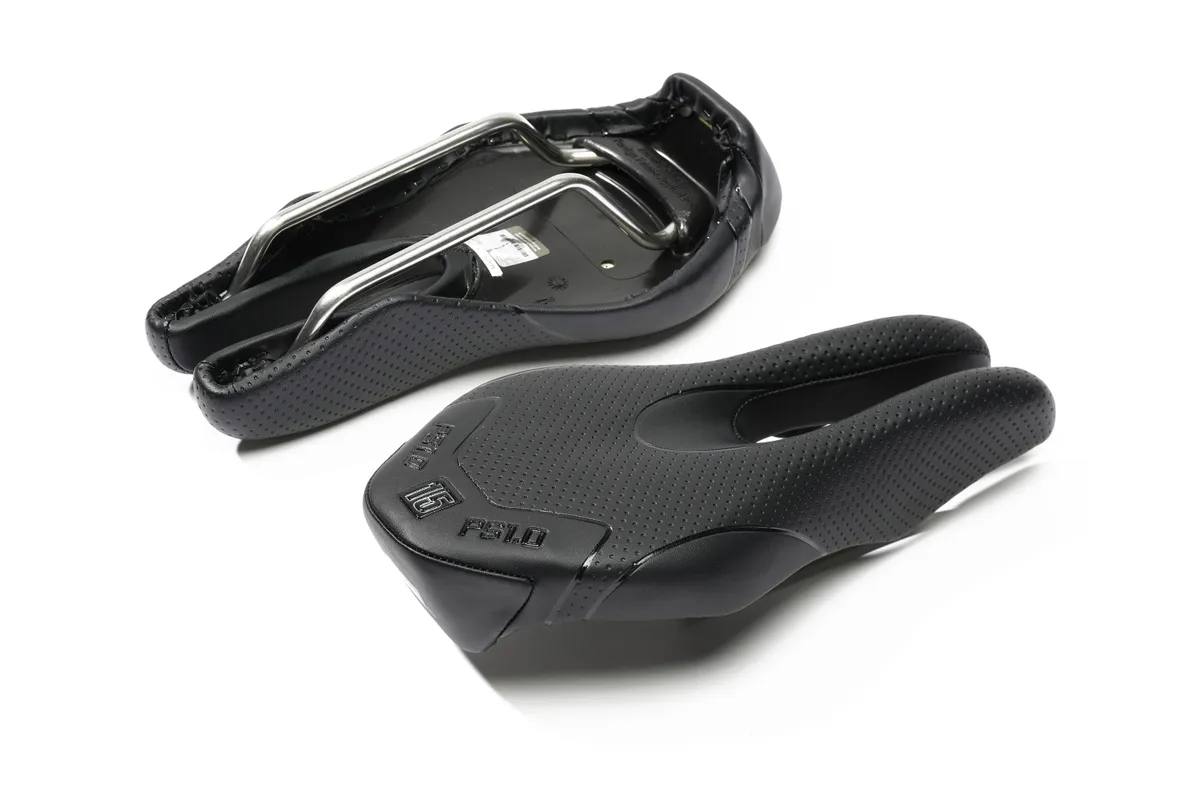
- £230
ISM’s noseless design has titanium rails, weighs 253g and sits in their Performance Short category. The PS1.0 is the brand’s recommendation for aggressive racers who want a fixed position, featuring firm padding and a slight slope at the front to support the hips in the TT position.
On the road we instantly hit it off, the ISM proving the best of the bunch at preventing excessive movement, while also being super comfortable.
The wide arms caught our sit bones a little when we came out of a tuck, so if you like to sit up or move a little then ISM’s Performance Narrow range might suit you better.
ISM saddles have solved the bottom woes of many a triathlete over the years, so they’re worth a punt if you can’t get on with more traditionallooking seats.
Verdict: A highly recommended saddle if you suffer with the dreaded numb-bum
Score: 90%
Prologo Dimension Tri Nack 143
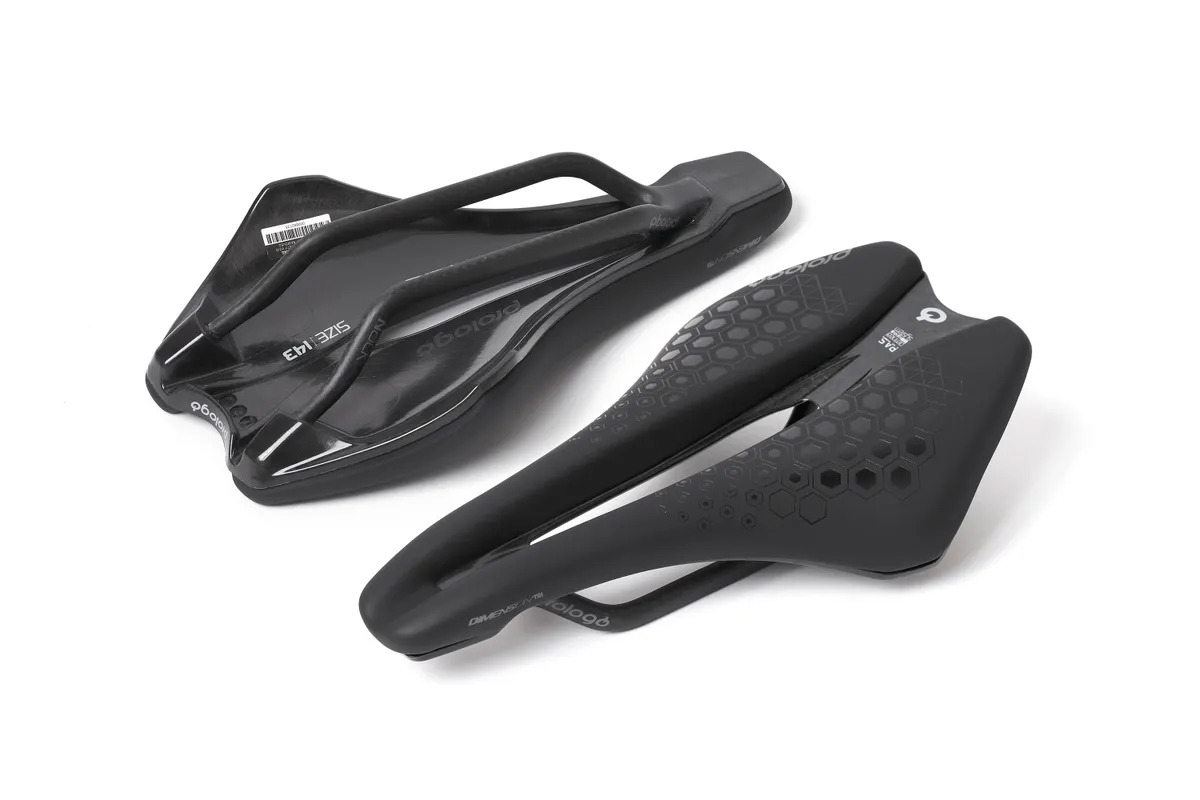
- £166.99
Prologo’s Dimension Tri weighed in at just 179g on our scales, and is designed for ‘comfort when on the drops and for aggressive riding’, suggesting road/ITU-style racing as well as long-course suitability.
In both the drops and on the tri-bars we found the Dimension Tri very comfortable on long rides, with the 143mm wide shell and central cut-out providing a wide and pressure-relieving seat.
The nose is quite a lot narrower than the other stubby tri saddles on test, so it’s worth trying before buying if intended for middle or long-distance.
It’s almost £60 more for the CPC version with an anti-slip cover, that also claims to provide shock absorption and air cooling, but unless you really struggle with numbness then this or the cheaper Tirox railed version should suffice.
Verdict: An impressively light and versatile all-rounder that offers great value
Score: 86%
Fizik Transiro Mistica

- £164.99
The Transiro Mistica has received much praise in previous 220 grouptests, and this version with Kium rails (a titanium/ alloy blend) gives you all the comfort and performance for a small weight penalty (239g, regular size) compared to the carbon style (205g).
The extra-long rails offer plenty of scope for you/ your bike fitter to find your perfect position, while the padding has excellent grip; when we found our groove, it did a superb job of keeping us securely in position.
The nose is super wide, and we found it very comfortable for extended periods out on the tribars. The ‘carriage kit’ allows you to store two bottle cages and flat kit conveniently, securely, and out of the wind.
If it suits you then the Mistica has everything you need from a tri saddle, and is perfect for longdistance.
Verdict: Grippy, comfortable and purpose-built for long-distance triathlon
Score: 93%
Bontrager Hilo Comp tri saddle

- £59.99
This split-nose option from Trek’s accessories brand is reminiscent of ISM’s popular saddle design yet, on the Hilo Comp, there’s a shell underneath the split-support zone all the way to the end of the nose. With steel rails and deep dual-layer foam it’s the heaviest on test at 332g, though Bontrager say the base has extra flex for compliance.
While in theory it should be ideal for triathlon, we found the split section a little narrow with a maximum width of 134mm. That’s not to say the Hilo Comp’s not an affordable option for those who require extra pressure relief in the time-trial position, but it just didn’t work for us.
We were far more impressed with Bontrager’s Aeolus saddle, which weighs a third less and picked up a Best Value gong in our 2019 saddles test.
Verdict: Weighty saddle that is good value and pressure-relieving
Score: 75%
ISM PS 2.0

- £170
The PS 2.0 (no relation to the computer console) is one of the newest saddles in ISM’s range. ISM’s noseless design is based on the company’s independent research, which tests their saddles against competitors to ensure maximum blood flow to reduce numbness down below.
The PS 2.0 - suitable for road or tri according to ISM - features an upward slope at the back, designed to provide extra hip support when rotated in the aero position or an aggressive road stance.
It means that those who tend to move around a lot in the saddle might struggle to fix themselves perfectly on it. Not us.
We found it hugely comfortable and it’s one of the few saddles we’ve tested that kept us completely fixed in the TT position for two hours or more without wanting to shuffle.
Verdict: One of ISM’s best tri-specific saddles yet. also suitable for road bikes
Score: 90%
Fizik Vento Argo R5
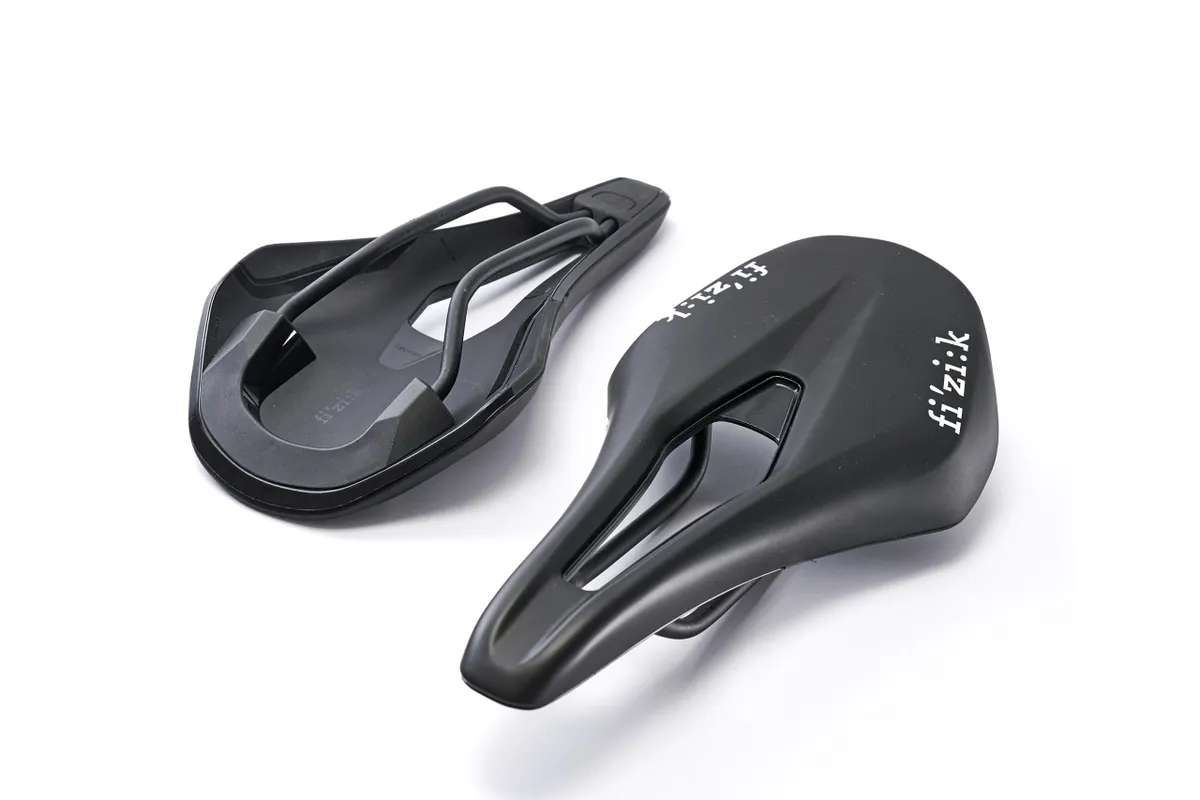
- £99.99
Fizik were late to the party when it came to short-nosed saddles with central channels. Now, though, they offer many options with open sections and shorter noses.
The Vento Argo R5 weighs in at 232g with alloy rails and is priced at the lower end of their performance-orientated range.
It’s aimed more at road riding compared to their tri-specific Mistica, but the width of the nose may still serve some riders well on a tri bike.
It comes in 140mm or 150mm sizes – useful for fine-tuning fit and finding a perfect groove. After some trial and error, we found ourselves planted very comfortably on the Vento Argo R5, with Fizik’s Type 1 foam providing just enough padding.
It’s on the firmer end, so might not work for those who prefer some extra cushion.
Verdict: Another saddle that could work for road riding or triathlon
Score: 87%
Fabric Tri Race Flat

- £79.99
This saddle’s become a firm favourite round here in recent times and the extra accessories – including a rear bottle mount and a hook for bike racking – make it excellent value.
It tips the scales at 235g, and the central channel is recessed enough that it does the same job as saddles with an open channel.
Fabric say this is so they can bond a waterproof microfibre cover straight onto the base, which they claim is softer than stretched-cover saddles.
For us, it offered just the right amount of firmness and pressure relief, and the wide split section nose is ideal for keeping you comfortable in an aggressive position.
This titanium-railed version also hits the value sweet spot, as we can detect no discernible difference compared to the £139.99 Tri Flat Pro with carbon rails.
Verdict: Incredibly good-value saddle that’s born to race triathlon
Score: 93%
Prologo Dimension Tri Tirox 143
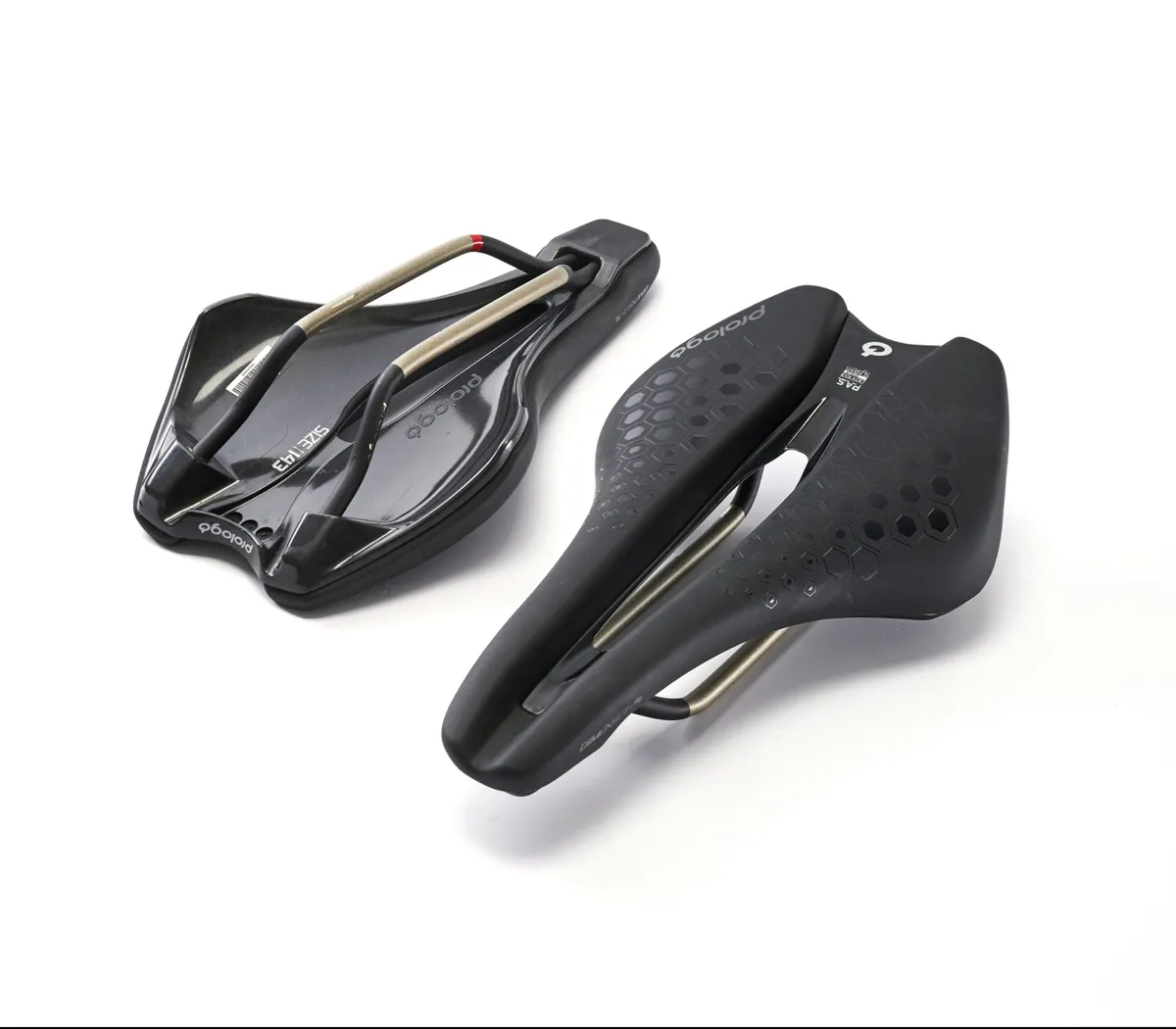
- £119.99
The Dimension Tri features Prologo’s ‘Tirox’ rails, which has an alloy-steel construction to bring the price down considerably lower than the carbon-railed version.
The weight is still impressively low at 219g, and Prologo say the 143mm width should allow for better distribution of the rider’s body weight.
The nose is noticeably narrower than the other tri-specific saddles in this test, but for us it worked a treat, and was also very comfortable on a road bike because of the wider seating area.
Like Prologo’s Tgale, their PAS channel runs down the centre to maximise blood flow and prevent excess pressure, and we found the foam was an ideal thickness without being too squishy. For us, this is the pick of the two Prologo saddles on test.
Verdict: Excellent all-rounder that provides high comfort at a low weight
Score: 88%
Pro Aerofuel
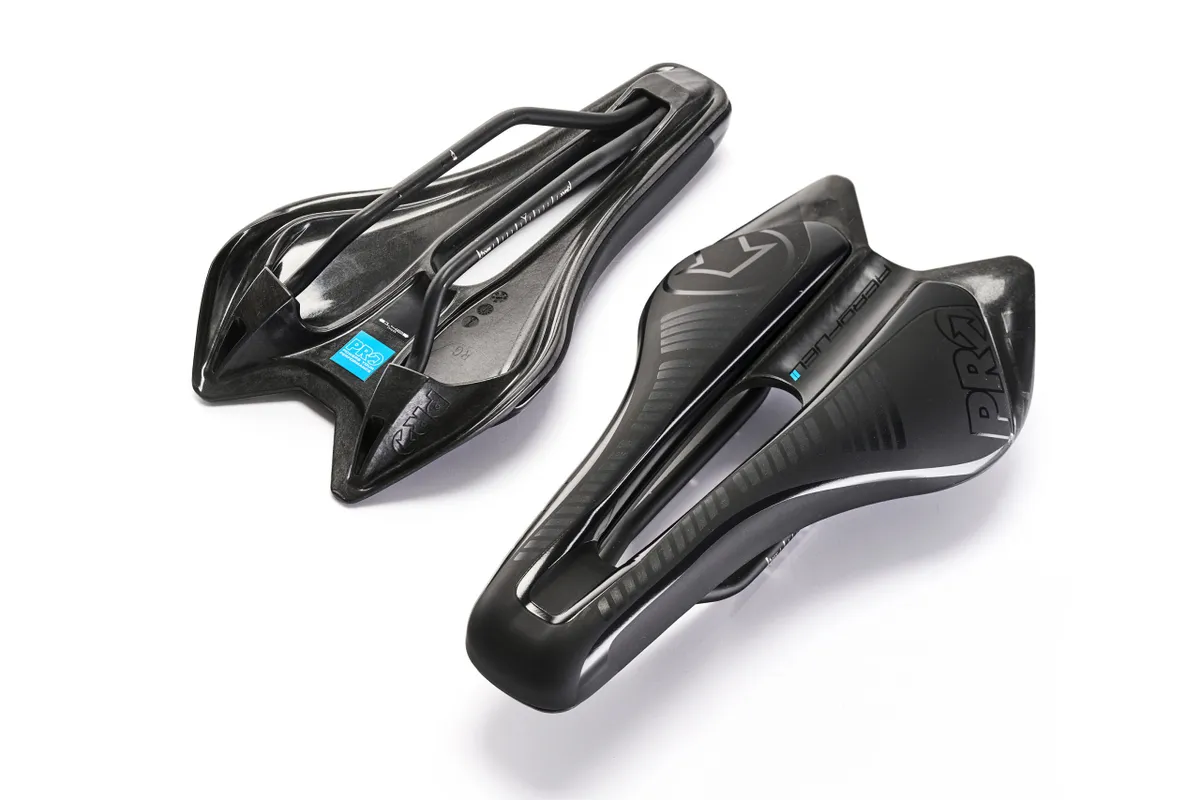
- £129.99
This hollow stainless-steel-railed model is impressive, weighing just 193g and feeling very similar to the top-end carbon model that’s £50 more expensive.
At its widest point, the Aerofuel is 142mm across, and has a non-slip cover that held us firmly in position without any annoying excess movement.
The EVA padding becomes thicker towards the nose to offer more support when riding in an aggressive position but, for when you need to sit back, it’s also comfy towards the rear.
The central cut-out is 2cm wide and provides ample pressure relief; we’ve put in many monstrous rides on the Aerofuel with no numbness or discomfort. It’s a saddle that grows on us every time we test it and we’ve no doubt that many will find it ideal for tri.
Verdict: Light and very comfortable; out performs many more expensive models
Score: 91%
Prologo Tgale PAS

Prologo’s tri-specific Tgale comes with their Perennial Area System (PAS), which aims to prevent numbness in the pelvic region.
In all honesty, it’s an innovation we’ve never fully got on with, finding the nose section a little firmer than the likes of Pro’s Aerofuel and the Fabric Tri.
On the positive, the grip sections on the microfibre cover are a nice addition to prevent slippage. This top-of-the-range version has Prologo’s Nack Carbon oversized rails, and at 243g it’s not the lightest out there.
It’s also rather expensive, so if the shape and design is for you then the Tirox-railed version at over £100 less is worth considering if you’re on a budget.
For adding rear bottle cages and/or a toolkit, the Tgale is compatible with Prologo’s U-Cage mounting system.
Verdict: Packed with useful triathlon-specific features but it’s pretty pricey
Score: 77%
